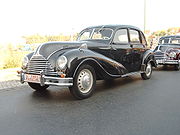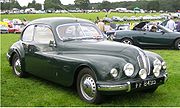
BMW 326
Encyclopedia
The BMW 326 is a relatively rapid medium sized sedan produced by the Bavarian firm
between 1936 and 1941, and again briefly after 1945. It had an innovative design and sold well despite its relatively high price. It also had an unusually involved afterlife.
, and first presented in February at the 1936 Berlin Motor Show
, the 326 was offered for sale from May of that year. Featuring a box chassis that could readily be adapted for derivative models, the 326 was the first BMW available with four doors. Also innovative were the torsion bar rear suspension and the hydraulic brake control. The car was offered as a four door sedan and as a two or four door cabriolet. The BMW 320
, BMW 321
, BMW 327
, and BMW 335
were based on the 326. The streamlined form of the body contrasted with previous relatively upright BMWs: drag was presumably reduced further by including a fixed cover over the spare wheel at the back.
carburetors to produce a claimed maximum output of 50 PS at 3750 rpm. The advertised Autobahn top speed was 115 km/h (72 mph).
The four speed gear box was supported by freewheeling on the bottom ratios and synchromesh on the top two.

 In 1945, Eisenach
In 1945, Eisenach
was occupied by US forces. However, the wartime allies had already agreed that Thuringia
would fall within the Soviet occupation zone. The plant that BMW had originally acquired in 1929 was not fully destroyed, and it was possible for returning survivors to assemble a small number of postwar 326s. A modernised version, badged initially as the BMW 340
, emerged around 1948. Despite the nomenclature, it was clear that BMW’s Eisenach plant
was no longer under the control of BMW: later BMW 340s, still based on the prewar 326, were badged as EMW 340s following a protracted dispute concerning title to the BMW name. It was, perhaps, a tribute to the 326's perceived excellence, together with the skills of the workers who had struggled to revive it, that the Eisenach plant was permitted to produce the BMW design till approximately 1955, long after the Auto Union
assembly facilities at nearby Zwickau
had been dismantled and removed to Russia as part of the war reparations package.
The Russians were not alone in being impressed by the 326. Detailed plans of the sedan and coupé derivative models were also rescued by the British. Family connections, involving the founder of the Bristol Aeroplane Company
and a Frazer-Nash director who had imported to England and adapted BMW designs in the 1930s, led to Bristol. A succession of Bristols cars
introduced between 1947 and 1953 were unapologetic developments of the respected BMW design. Ten years after the war's end, Bristol’s 403
produced between 1953 and 1955 retained a BMW style front grill: under the skin the engine had been extensively upgraded, and the Bristol 403 now offered a claimed output of 100 bhp. The engine size, at 1971 cc, was unchanged, however.
BMW
Bayerische Motoren Werke AG is a German automobile, motorcycle and engine manufacturing company founded in 1916. It also owns and produces the Mini marque, and is the parent company of Rolls-Royce Motor Cars. BMW produces motorcycles under BMW Motorrad and Husqvarna brands...
between 1936 and 1941, and again briefly after 1945. It had an innovative design and sold well despite its relatively high price. It also had an unusually involved afterlife.
New thinking
Designed by Fritz FiedlerFritz Fiedler
Fritz Fiedler , a qualified engineer, joined the BMW firm in 1932 as chief designer at the age of 32 after working for Horch, designed 8 cylinder and 12 cylinder cars. Working with Fiedler was Rudolf Schleicher, who had joined Horch in 1927 after being at BMW on their motorcycle design team...
, and first presented in February at the 1936 Berlin Motor Show
Auto show
An auto show, or motor show, is a public exhibition of current automobile models, debuts, concept cars, or out-of-production classics. It is commonly attended by automobile manufacturers. Most auto shows occur once or twice a year...
, the 326 was offered for sale from May of that year. Featuring a box chassis that could readily be adapted for derivative models, the 326 was the first BMW available with four doors. Also innovative were the torsion bar rear suspension and the hydraulic brake control. The car was offered as a four door sedan and as a two or four door cabriolet. The BMW 320
BMW 320
The BMW 320 was a saloon car manufactured by BMW from 1937 to 1938. It replaced the 319-based BMW 329.The 320 was built on a shortened BMW 326 chassis and used a 326 engine with a single carburettor and an output of...
, BMW 321
BMW 321
The BMW 321 is a compact six cylinder sedan sedan produced by the Bavarian firm between 1938 and 1941. After 1945, production resumed at the Eisenach plant: 321s were built again between approximately 1945 and 1950, probably in greater numbers than before the war.-The launch:The 321 was introduced...
, BMW 327
BMW 327
The BMW 327 is a medium sized touring coupé produced by the Bavarian firm between 1937 and 1941, and again produced after 1945. It sat on a shortened version of the BMW 326 chassis.-Launch:...
, and BMW 335
BMW 335 (1939 - 1941)
The BMW 335 is six cylinder sports sedan produced by the Bavarian firm between 1939 and 1941.-The Market:Commercial success for the BMW 326, introduced in 1936, encouraged a move upmarket...
were based on the 326. The streamlined form of the body contrasted with previous relatively upright BMWs: drag was presumably reduced further by including a fixed cover over the spare wheel at the back.
The engine
The 1971 cc straight 6 engine was a slightly bored out version of the 319’s power plant. In the 326 application, it was fed by twin SolexSolex
Solex was a French manufacturer of carburetors and the powered bicycle VéloSoleX.The Solex company was founded by Marcel Mennesson and Maurice Goudard to manufacture vehicle radiators...
carburetors to produce a claimed maximum output of 50 PS at 3750 rpm. The advertised Autobahn top speed was 115 km/h (72 mph).
The four speed gear box was supported by freewheeling on the bottom ratios and synchromesh on the top two.
Commercial
The 326 was a success. By the time production was suspended in 1941, the Eisenach plant had produced 15,949.Afterlives


Eisenach
Eisenach is a city in Thuringia, Germany. It is situated between the northern foothills of the Thuringian Forest and the Hainich National Park. Its population in 2006 was 43,626.-History:...
was occupied by US forces. However, the wartime allies had already agreed that Thuringia
Thuringia
The Free State of Thuringia is a state of Germany, located in the central part of the country.It has an area of and 2.29 million inhabitants, making it the sixth smallest by area and the fifth smallest by population of Germany's sixteen states....
would fall within the Soviet occupation zone. The plant that BMW had originally acquired in 1929 was not fully destroyed, and it was possible for returning survivors to assemble a small number of postwar 326s. A modernised version, badged initially as the BMW 340
BMW 340
The BMW 340, subsequently rebadged as the EMW 340, was a large six cylinder four door passenger saloon produced at Eisenach initially in the name of BMW. Five door 340 station wagons were also manufactured...
, emerged around 1948. Despite the nomenclature, it was clear that BMW’s Eisenach plant
Automobilwerk Eisenach
The Automobilwerk Eisenach was an automobile manufacturer in Eisenach, Germany.-Fahrzeugfabrik Eisenach:Heinrich Ehrhardt founded the Fahrzeugfabrik Eisenach in Eisenach on 3 December 1896 as a stock company...
was no longer under the control of BMW: later BMW 340s, still based on the prewar 326, were badged as EMW 340s following a protracted dispute concerning title to the BMW name. It was, perhaps, a tribute to the 326's perceived excellence, together with the skills of the workers who had struggled to revive it, that the Eisenach plant was permitted to produce the BMW design till approximately 1955, long after the Auto Union
Auto Union
Auto Union was an amalgamation of four German automobile manufacturers, founded in 1932 and established in 1936 in Chemnitz, Saxony, during the Great Depression. The company has evolved into present day Audi, as a subsidiary of Volkswagen Group....
assembly facilities at nearby Zwickau
Zwickau
Zwickau in Germany, former seat of the government of the south-western region of the Free State of Saxony, belongs to an industrial and economical core region. Nowadays it is the capital city of the district of Zwickau...
had been dismantled and removed to Russia as part of the war reparations package.
The Russians were not alone in being impressed by the 326. Detailed plans of the sedan and coupé derivative models were also rescued by the British. Family connections, involving the founder of the Bristol Aeroplane Company
Bristol Aeroplane Company
The Bristol Aeroplane Company, originally the British and Colonial Aeroplane Company, was both one of the first and one of the most important British aviation companies, designing and manufacturing both airframes and aero engines...
and a Frazer-Nash director who had imported to England and adapted BMW designs in the 1930s, led to Bristol. A succession of Bristols cars
Bristol Cars
Bristol Cars is a manufacturer of hand-built luxury cars headquartered in Patchway, near Bristol, United Kingdom. Bristol have always been a low-volume manufacturer; the most recent published official production figures were for 1982, which stated that 104 cars were produced in that year...
introduced between 1947 and 1953 were unapologetic developments of the respected BMW design. Ten years after the war's end, Bristol’s 403
Bristol 403
The Bristol 403 is a luxury car which was produced between 1953 and 1955 by British manufacturer Bristol Aeroplane Co. . The 403 was the third of the eventual five series of Bristols powered by the BMW-derived pushrod straight-six engine...
produced between 1953 and 1955 retained a BMW style front grill: under the skin the engine had been extensively upgraded, and the Bristol 403 now offered a claimed output of 100 bhp. The engine size, at 1971 cc, was unchanged, however.

